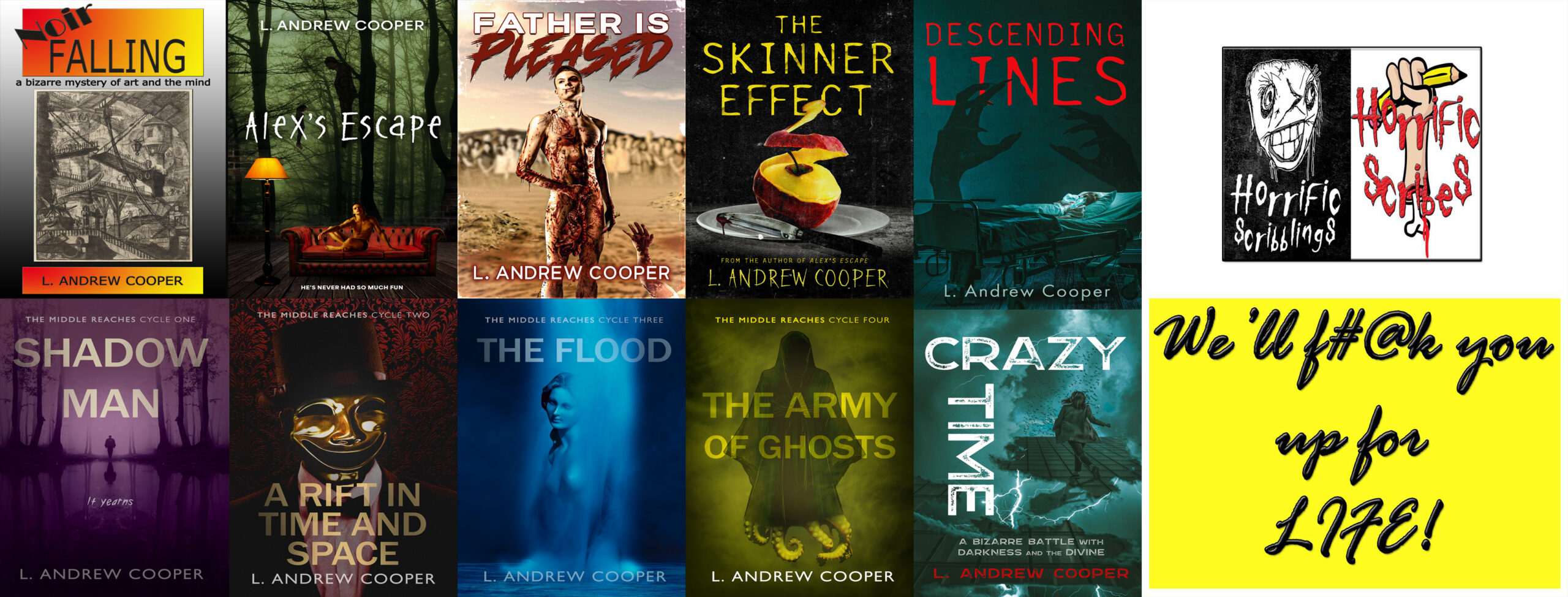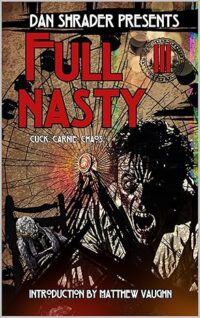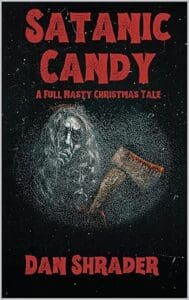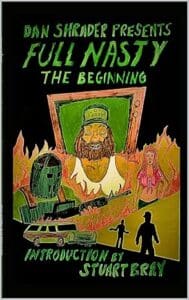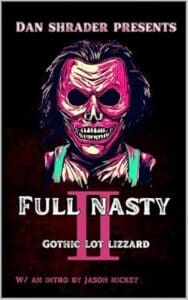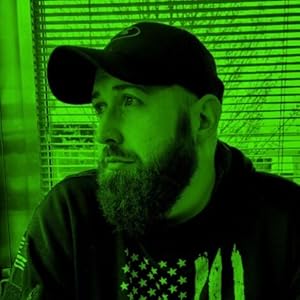Skilled mixologist of extreme horror and twisted humor Dan Shrader discusses loves, hates, 80s bands, and other inspirations that make the latest Full Nasty stories, Full Nasty III and Satanic Candy: A Full Nasty Christmas Tale, so very full of delightful nastiness.
Full Nasty III
You know the name! You know the drill!
The Hell-wagon has a full tank of gas for this trip.
Satanic Bill is back and more unhinged than ever before!
Buckle up, little termites, for a ride down memory lane in one of the most bizarre installments of the series yet!
Satanic Candy: A Full Nasty Christmas Tale
Satanic Bill and Candy’s relationship is stronger than before. Their love is as sweet and ripe as a decaying corpse in the summertime, but the holidays are almost here! Before advancing to Full Nasty Films, Bill thinks it’s necessary to resolve certain issues from Candy’s past. Those who wronged her are facing consequences one by one, leading to the final chapter.
Our modern-day Bonnie and Clyde are taking a road trip for your enjoyment. To celebrate this winter season, let’s decorate with tinsel made of eyeballs and innards. Cook some bodies over the open flame. Cuddle up with someone special and read this late-night fairy tale of love!
Stuff your stockings with Satanic Candy this holiday season, and Bill will make sure your holes are filled!
The Interview
Full Nasty III
NOTE: Some questions apply to the whole Full Nasty series. When they do, feel free to refer to parts one and two, but please focus on how part three develops the issues the questions raise.
1. The Art of Being Offensive. As your highly entertaining trigger warning promises, the book features ableism, homophobia, and other attitudes (and related language) most people would consider objectively offensive, along with the graphic rape, torture, and murder, of course, and in most contexts, such things might offend me. However, I find your “offensive” content not only personally inoffensive (n.b. I have a disability and am gay) but… quite humorous. I know I’m not alone. Am I, and are people like me, fucked in the head? Why or why not? I’m giving you credit for this little trick—how do you pull it off? How do you find so much humor in horror, and what inspires your special combination?
DS: I’ll be honest, I’m the last person to cast stones in this glasshouse. The Full Nasty books reflect my dark and twisted sense of humor. I’m not a fan of trigger warnings, and when writing this one I thought it would add to the humor to prepare the reader just by meeting Bill right off from the beginning. Figured I’d take a new approach to the trigger warnings out there. Full Nasty humor is either loved by those who get it or hated by those who don’t. I’m not sure how I even pull it off. To me, it’s just me being me, writing what I think is funny and horrific, or normalizing some of the shit we see every day. Perhaps my profession has a lot to do with it. Being a Corrections Officer, I have gallows humor about most things. Prior to working at a prison, I worked 8 years in a psychiatric treatment facility for youth, so… maybe that explains some of it?
2. Reading the Movies. The title for your series refers the “Full Nasty” videos—porn combining sex and violence, often or always snuff, I’m not sure—produced by your main character, Satanic Bill. Why build books around videos (one medium around another)? Some chapters are the content of a Full Nasty, as if the chapter were itself a video, and at the beginning of Part Three, there’s “a break in the reel” that interrupts the story. Does Full Nasty III as a whole simulate a movie—are “readers” really moviegoers? Extreme horror more generally has a fascination with film, especially snuff, from Srdjan Spasojevic’s influential movie A Serbian Film (2010) to the more recent book Broken Pieces of June by Stuart Bray, who wrote the intro to the first Full Nasty. What motivates this fascination? In your work and in your bio (below), you seem a bit nostalgic for video… why the nostalgia?
DS: Nostalgia checks all the boxes on this. Organizing the book around videos enhances its realism and intimacy, in my opinion. We all remember watching those gritty video nasties back in the day. I think photographs and films just makes it more tangible and terrifying when you think about it. Not only are these people doing fucked up shit, but they’re filming it! Now you’re in it!
My love for horror began when I stumbled upon boxes of VHS tapes that belonged to my grandparents. It turns out my grandmother had a fascination with recording everything when it first became popular. Those late-night movie binges were a rush, even though I knew I shouldn’t be watching them.
I had a strong bond with my grandparents. I looked up to them and hung out with them a lot growing up. I dedicated my first book I published to them as well. They got me my first typewriter and encouraged me to write horror stories. Their support and care meant the world to me, and I miss them every day. Even now, when I watch films like C.H.U.D., Halloween, or Texas Chainsaw Massacre, the same ones I first experienced from that box, it somehow brings me closer to them again.
3. Nonlinear Storytelling. Full Nasty III follows different timelines, often jumping forward or backward on one and/or from one to another as it moves from chapter to chapter. Why did you choose this structure instead of a more typical, chronological order of events? The “ride down memory lane” promised in the book’s description is closer to a rollercoaster. Do you think most readers can hang on as you zoom from one point in the story to another? Going back to earlier ideas, do you think these quick jumps to different scenes at different moments make the book more film-like, with the quick jumps being like quick cuts? If so, did that just sort of happen, or was it a matter of design?
DS: I believe that if I had written the story in chronological order, it wouldn’t have had the same impact. Going from the first book to the third in the order of events might not have captured the audience as effectively or been a good way to tell the story. The back-and-forth style of the Full Nasty books, similar to film reels and editing, seems to be popular with readers. To be honest, this is just how it naturally came together as I wrote, bouncing back and forth between different scenes. I spent years writing screenplays and have always had a raging hard on for Quentin Tarantino’s nonlinear style.
4. The Religious Stuff, etc. Satanic Bill sometimes gets snippy when people leave out the “Satanic” part of his name, and he at least gives lip-service to being the son of Satan or one of Satan’s legions. With Satanic Bill, however—kind of like the book as a whole—I’m not sure what to take seriously. Sure, Satanic Bill is into some evil shit, but the supernatural appears to be absent. Do you see actual religious stakes in this book, real God/Satan stuff behind the scenes? To get further into potential lore, what can you tell us about the mysterious “Employer?” Who makes the “underworld laws?”
DS: For this question, Satanic Bill is full of shit and enjoys fucking with people. It’s hard to take him seriously, and with this story, shit the whole series, there is no supernatural element involved. As you go through the books you will see his descent into madness more and more. As for the “Employer” and the “underworld laws” aspect of Full Nasty—that will have to remain a secret for now. There’s still more to come.
5. Depeche Mode. How does Full Nasty III’s “playlist” help characterize the novel? Having the list up front makes songs’ appearances in the story more fun, but I never felt sure what to think of the music from the perspective of Bill’s universe. Is this bad (possibly cuck) music or good music? “Safety Dance” by Men without Hats just seems funny, but “Personal Jesus” by Depeche Mode seems a little more loaded. Does the choice of “Personal Jesus” have anything to do with Bill calling himself “The Messiah?” Depeche Mode doom and gloom doesn’t fit with the lighthearted nastiness of your work… does it? Why or why not?
DS: To be honest, with the music side of Full Nasty, I picked those songs because the 80s Euro-invasion music was big during that era, and I like those songs, so in my mind it seemed fitting for the off the wall nature of Bill. How often do you read about a guy like this with a taste for music like Men Without Hats and The Bangles? I really felt Bill listening to heavy metal, black metal, or death metal would just be what is expected and seems to be the normal go-to for these types of character. I didn’t want to follow the little bullet points of a normal psychopathic killer that you read about regurgitated over and over. His odd taste in music gives him some depth, makes him different than the rest. To me I didn’t really have any correlation with “Personal Jesus” and Bill calling himself the Messiah. Bill just says off the wall shit. When I started the idea and writing it, there wasn’t really much thought about it—Bill did his thing in my brain, and I wrote it. I wanted to get gritty but also show off my twisted humor. Apparently, people like it.
6. Cannibalism = Orgasm. Your book makes clear that Satanic Bill’s appetites are not singular; his videos have an audience because, as a character comments, “people love violence and sex… the ultimate taboo.” Bill might not be the only one prone to ejaculate when he sees his lover eat human flesh. How common do you think such appetites really are? How like Bill’s audience is your audience? How much are you like Bill? How much fun was teaching readers the word “erotophonophilia?”
DS: I believe it’s more common than many people think it is. There’s a community that exists between men and women who have a strange fetish for being eaten or swallowed alive. Not all of them wish to die, either, while it’s happening, but there are some. It’s quite intriguing to read about. I think we’ve all heard of the man in Germany who was willingly eaten and killed by someone he met online. They both ate his penis together, too, or something like that.
Bill’s audience finds pleasure in his actions and is either worse or just as bad as him from my perspective. My audience, on the other hand… I hope they just enjoy reading about a fictional character’s misdeeds on mankind. I can relate to Bill’s strange sense of humor if anything. Necrophilia has never crossed my mind personally, but who knows, I might be missing out on something. But I enjoy making quirky comments and laughing at silly things. And it was fun playing with the word “erotophonophilia” in this one!
7. Killer Icons. Along the way, Satanic Bill meets a die-hard serial killer fan who puts him on a pedestal. Serial killer fandom is, of course, real, but not every serial killer becomes a celebrity. What do you think turns a real killer into an icon? Do the same qualities turn a fictional killer into an icon? Why or why not? As Satanic Bill’s story, world, and reputation grow, what qualities do you hope will make him stand out from the crowd?
DS: I believe that being frightened and entertained somehow goes hand in hand with this. The line between reality and fiction gets blurred, and this makes serial killers iconic and captivating figures in pop culture. Their actions are mysterious to us, and we want to know why they are the way they are. With fictional killers, we get popcorn versions of the real-life monsters, and, in a way, it desensitizes the reality behind the heinous crimes they commit.
Satanic Bill embodies pure evil and takes pleasure in it. He disregards others, viewing them as worthless, plain and simple. What sets him apart is his uniqueness—there is no other character like him. He’s only ever loved Candy—who has been dead for years, and no matter what he does, something always reminds him of her. It’s a fucked-up love story.
Satanic Candy: A Full Nasty Christmas Tale
8. Domestic Bliss. As the title promises, Satanic Candy: A Full Nasty Christmas Tale delivers nasty, demented Christmas and Christmas season settings and scenes. The result is a special focus on the love between Satanic Bill and Candy, an emotion that animates the carnage quite festively. It also puts a spotlight on domesticity: at one point, Satanic Bill and Candy are getting ready to move into a new house, start a new business, and in some ways set up like a proper couple. How does their version of domestic bliss relate to and reflect on typical (cuck?) domesticity? The book’s description (above) mentions their road trip and Bonnie and Clyde; the trip and the duo also reminded me of Mickey and Mallory from Natural Born Killers (1994). What inspires you to write this couple, especially their relationship and family-oriented tendencies?
DS: Well, I suppose if you look at it from that perspective, it might seem like a regular situation: the business, house, and everything. However, the truth is that they’re actually moving into a house that is currently undergoing renovation to become like their H. H. Holmes Kill Castle to have their smut films made in. For normal people, it’s kind of similar, settling down and getting a house and having a life together, but for Satanic Bill and Candy, this is their normal.
Mickey and Mallory are a great example as well. I found a lot of inspiration by reading about several real-life killer couples, such as Paul Bernardo and Karla Homolka, Ian Brady and Myra Hindley, and Gerald and Charlene Gallego.
9. Hating Christmas. A quotation sums up the situation nicely: “The laughter and excitement surrounding the whole Christmas holiday made Bill sick.” I’ve known a lot of people who find the holiday season miserable; as I discussed not long ago with screenwriter Mike Ede, there’s a reason it’s been a peak time for the horror genre for hundreds of years. Is Satanic Bill a spokesperson for the Christmas-negative, an oppressed minority, perhaps a silent majority? Why or why not? Do you think his feelings about the holidays are more personal, perhaps related to the childhood trauma touched on in Full Nasty III, or principled, an objection to the glitzy, cheery hypocrisy that he observes?
DS: Maybe he is. In a nutshell, Bill harbors a deep-seated hatred towards Christmas because his father hated it, and they never practiced it growing up. He was taught instead to find happiness in having sex with dead women, torturing people, and a bunch of other fucked up shit. To Bill, hating Christmas still makes his dead father proud, and he is always trying to impress him, wherever he is in hell. Bill isn’t interested in anything that’s the opposite of darkness. In his mind, nothing that happened to him as a kid was traumatic. Instead, it pushed him further towards becoming the devilish human being he always wanted to be.
10. Access! How can readers learn more about you and your works (please provide any links you want to share)?
DS: You can find me on TikTok, Instagram, Facebook, Bluesky, Goodreads, and Amazon. I also have a website with links to all my social media accounts and other content for you to follow or read more of my work: www.danshraderhorror.com
About the Author
Dan Shrader, hailing from Southern Indiana, is a mastermind of spine-chilling and depraved horror stories that will stay with you. One day, his life changed when he found a big box of VHS tapes. The box was filled with horror movies like The Texas Chainsaw Massacre, C.H.U.D, Black Christmas, and Night of the Demons. This discovery awakened a deep passion for horror within him. He has received nominations for two Horror Awards for his works Those Who Live in Darkness and The Devil’s Rite. Literary influences range from renowned authors, such as Clive Barker and Edward Lee, to Kristopher Triana and Brian Keene.
